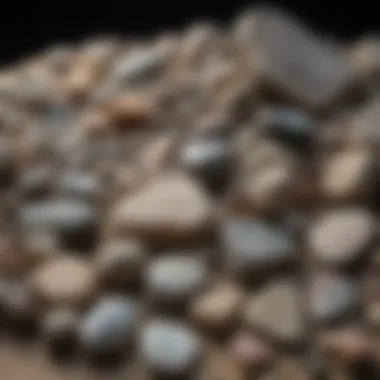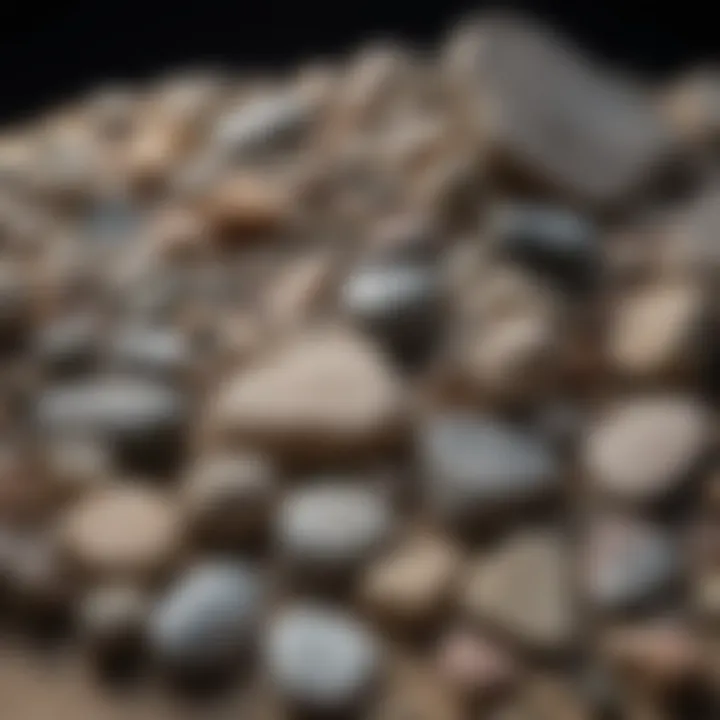Exploring Popular Crystals and Stones: Characteristics and Uses


Intro
Crystals and stones have long captured the interest of humanity. Their beauty, combined with mystery, has led to a rich history of fascination, collection, and study. This exploration will present various popular crystals and stones, emphasizing their unique characteristics, cultural significance, and practical applications. For rock and fossil collectors, understanding these natural artifacts offers both enlightenment and enjoyment.
History and Origins
The narrative of crystals and stones begins millions of years ago. The earth's geological processes have shaped them, producing an extensive variety that often reflects the environment in which they formed. The fascination with these materials has roots in ancient civilizations, where they were believed to possess special powers or healing properties.
Overview of Collectibles, Rocks, and Fossils
Collecting crystals and stones can be traced back to early human societies. Over time, people have gathered them for different reasons. Some were admired for their aesthetic qualities, while others held spiritual or medicinal value. The act of collecting has evolved into a vast hobby, often incorporating items like fossils. Each collectible carries a story, whether it’s the stone's journey through geological formations or its historical use by past cultures.
Historical Significance and Cultural Impact
Throughout history, crystals and stones have played significant roles in various cultures. They were often seen as symbols of power or status. For instance, the ancient Egyptians used lapis lazuli and turquoise in jewelry, emphasizing their connection to the divine. In Eastern traditions, jade was revered not only for its beauty but also for its representation of purity and moral integrity.
Over the centuries, materials like quartz and amethyst have been incorporated into rituals, believed to offer protection or attract prosperity. By understanding the cultural impacts of these materials, collectors and enthusiasts can appreciate the depth of significance that each crystal or stone holds.
Identification and Classification
Identifying and classifying crystals and stones involves understanding a few fundamental characteristics. Color, structure, and composition play critical roles in how a stone is categorized.
Guide to Identifying Rocks and Fossils
- Color: Observing the color can help suggest the type of stone. Although many stones can exhibit a range of colors due to impurities, certain hues often signify specific minerals.
- Hardness: The Mohs hardness scale provides a way to assess a stone's durability. Knowing this can help collectors gauge how to treat and display their collections.
- Luster: The way light reflects off a stone can indicate its mineral composition. Different types of luster include metallic, glassy, and dull.
- Crystal Structure: Some stones have specific shapes, indicating their crystalline forms. Learning these shapes is essential for proper identification.
Common Types and Variations
There are various types of popular crystals and stones, each showing unique characteristics:
- Quartz: A common mineral found in many geological environments. Known for its clear or colored varieties.
- Amethyst: A type of quartz that presents a purple hue, often associated with calming properties.
- Rose Quartz: Recognized for its pink color, believed to symbolize love and compassion.
- Agate: A banded stone that displays multiple colors, made mostly from chalcedony.
- Fossils: These are remnants or impressions left by ancient life forms, offering collectors a tangible connection to the past.
Understanding these elements will allow enthusiasts to explore their collections with greater depth and appreciation.
The journey through the world of crystals and stones is not just about collecting; it is about understanding the stories they tell and the history they represent.
Prelims to Crystals and Stones
The importance of understanding crystals and stones cannot be overstated. They have captivated human interest for centuries, serving roles from decorative elements to crucial industrial materials. Their unique properties and cultural significance can inform various fields, including history, geology, and personal well-being.
The Definition of Crystals
Crystals are solid substances where atoms are arranged in an orderly repeating pattern. This consistent structure contributes not only to their physical properties but also to their aesthetic appeal. Crystals can form through a variety of natural processes. These include cooling of molten lava or evaporation of mineral-rich water. Each type of crystal possesses distinct characteristics that influence their recognition and applications. For instance, quartz is one of the most prevalent types of crystals found in nature, recognized for its versatility and clarity.
The Definition of Stones
Stones, on the other hand, refer to naturally occurring solid aggregates of minerals or mineraloids. They can be shaped or cut into various forms for different purposes. Unlike crystals, which are defined by their formation, stones can include a wide range of materials, from minerals to organic matter. Common stones include granite, marble, and limestone. Their formation may involve complex geological processes, often taking millions of years to evolve. This diversity makes stones a fundamental part of both the earth's crust and human development.
Differences Between Crystals and Stones
Understanding the distinctions between crystals and stones is crucial for enthusiasts. While both are essential components of our natural world, they differ primarily in structure and formation.
- Structure: Crystals have a defined geometric shape due to their atomic arrangement, whereas stones may not necessarily exhibit such order.
- Formation: Crystals require specific conditions for their growth, while stones can form through a variety of geological processes.
- Uses: The usage of each can vary. Crystals are often utilized in metaphysical practices, while stones are integral to construction and industry.
The fascination with crystals stems from not only their beauty but also their positions in historical narratives and modern applications.
Types of Popular Crystals
The realm of crystals is vast and diverse, with each type presenting unique qualities and applications. Understanding different types allows us to appreciate their beauty, value, and function. This section serves as a guide, helping enthusiasts and collectors make informed choices about the crystals they explore, use, or collect.
Quartz: The Ubiquitous Crystal
Structure and Formation
Quartz is one of the most common minerals on Earth, characterized by a crystalline structure that forms through a process called crystallization. When silicon dioxide crystallizes, it can take forms including hexagonal prisms. This structure contributes to quartz's notable hardness, ranking at 7 on the Mohs scale.
The prevalence of quartz in various geological environments makes it easily accessible compared to other crystals. It’s advantageous for both collectors and users since it is not only beautiful but also widely available. Its durability means it can withstand everyday wear and tear, making it a popular choice for jewelry and decorative items.
Uses in Healing
In the realm of healing practices, quartz is often lauded for its purported energetic properties. Many believe it has the ability to amplify energy, balance emotions, and enhance spiritual growth. This belief leads to its frequent use in practices like meditation and crystal healing.
The versatility of quartz makes it appealing in this context. It can be used in various forms like spheres, points, or tumbled stones—each offering different methods of interaction. However, it is crucial to note the lack of scientific backing for these healing properties. While many appreciate the aesthetics and spiritual symbolism, others may seek empirical evidence before acceptance.
Industrial Applications
Beyond its metaphysical associations, quartz has vital industrial significance. It’s used in the manufacturing of glass, electronics, and even timekeeping devices due to its piezoelectric properties. This unique feature allows quartz to generate an electrical charge when subjected to mechanical stress, which is invaluable in creating accurate timepieces.
While its uses in industry are clear, the sustainability of sourcing quartz raises concerns. Large-scale mining operations may lead to environmental degradation. As industries seek efficiency, the impact of such extraction methods should remain in focus.


Amethyst: The Stone of Serenity
Color Variations and Origins
Amethyst varies in color from light lavender to deep purple, a result of iron impurities in its quartz structure interacting with radiation during its formation. Its color may influence its desirability, with deeper hues often fetching higher prices.
Originating from various locations worldwide, including Brazil and Uruguay, amethyst is notably found in volcanic rock formations. Such geological origins offer insight into its quality and rarity, which can enrich a collector's appreciation.
Symbolism and Lore
Historically, amethyst has been associated with tranquility and balance. Ancient Greeks believed it could prevent drunkenness, and many cultures have woven it into their lore as a stone of protection and power.
This symbolism adds emotional value to amethyst, enhancing its appeal in jewelry and spiritual practices. However, the subjective nature of symbolism can lead to varying interpretations, making it essential for collectors to seek well-documented histories.
Contemporary Usage
Amethyst occupies a prominent place in modern design and spiritual applications. It is frequently used in jewelry, home decor, and even therapeutic gadgets. Its calming color makes it a favorite among designers.
Despite its popularity, skeptics exist regarding its efficacy in healing. In contemporary contexts, often, the aesthetic value overshadow its alleged metaphysical properties, prompting discussions on balance between beauty and belief.
Citrine: The Merchant's Stone
Chemical Composition
Citrine is another type of quartz, distinguished by its yellow to orange hues, attributed to iron content and radiation exposure. Its vibrant colors result from the same silica composition as quartz, which ensures its durability.
Understanding citrate's chemical makeup can enhance appreciation for its natural origin. Its resilience makes it favorable for various uses, from jewelry to decor. However, ensuring it is genuinely natural, not heat-treated amethyst, can be a challenging aspect for collectors.
Historical Significance
Citrine has a rich historical narrative, cherished by ancient civilizations. It was often considered a merchant's stone, believed to bring wealth and prosperity. Many cultures have valued it for its aesthetic properties and its association with abundance and success. This history grants citrine cultural relevance, appealing to those interested in its past.
However, this historic appeal can lead to misunderstanding. Some may grasp superficial benefits while overlooking deeper meanings.
Sourcing and Rarity
Natural citrine forms are uncommon, leading to increased reliance on heat-treated stone, which mimics its color. This sourcing aspect raises questions about authenticity in the market. Authentic citrine is sought after, while treated stones remain more accessible.
Considering these factors is essential for buyers and collectors, especially when evaluating value. It challenges the market perception of rarity and authenticity, compelling collectors to remain aware of their purchases.
Lapis Lazuli: The Royal Gem
Geological Origins
Lapis Lazuli primarily comes from the mountains of Afghanistan, where it forms in marble deposits. The unique geological conditions lead to the formation of this striking blue stone, often flecked with golden pyrite.
This rarity of geographical sourcing adds to its lore as a royal stone. In ancient civilizations, lapis lazuli was used in ceremonial objects, enhancing its cultural significance. Its historical context can appeal to collectors who value heritage and authenticity.
Famous Artifacts
Some of the most treasured artifacts in history contain lapis lazuli. The burial mask of Tutankhamun is a prime example, wherein the stone symbolizes power and protection. Such artifacts place Lapis Lazuli in a narrative that transcends its physical beauty.
However, replicating the authenticity of ancient artifacts can present challenges for collectors. The demand for such treasures often drives up prices, making genuine items highly sought after.
Modern Applications
In contemporary contexts, lapis lazuli is often seen in jewelry and artistry, encapsulating its beauty for everyday use. The stone’s attractiveness has led to its use in high-end designs, further preserving its status in the modern world.
However, its popularity can lead to overproduction and, subsequently, issues related to sustainable sourcing. As with many natural stones, balancing demand with responsible extraction practices remains an ongoing concern.
Types of Popular Stones
Understanding the various types of popular stones is crucial for enthusiasts and collectors alike. Different stones possess distinct characteristics, historical backgrounds, and practical applications. By delving into these aspects, collectors can make informed choices, whether for aesthetic purposes, functionality, or investment.
Granite, marble, slate, and limestone are staples in the realm of stones. Each type has unique properties that make it suitable for various uses, from construction to art. Assessing these characteristics helps one appreciate their value and significance in both historical and contemporary contexts.
Granite: The Sturdy Stone
Granite is widely recognized for its robustness and is favored in many applications due to this key characteristic.
Formation Processes
Granite's formation involves the cooling and solidification of magma beneath the earth's surface. This process results in a coarse-grained texture, making it visually appealing. Its durability is advantageous; it withstands wear and tear, making it an ideal choice for countertops and flooring.
Architectural Uses
Granite has extensive use in architectural applications. Its strength offers reliable structural integrity, making it popular in buildings, monuments, and bridges. Architekts often choose granite for its aesthetic appeal as well, as it can be polished to a shiny finish. However, its weight can be a downside, potentially requiring more substantial support structures.
Environmental Impact


The extraction of granite can lead to significant environmental effects, particularly in terms of land disturbance. This activity often disrupts local ecosystems. Despite this, granite's longevity in construction minimizes the frequency of replacement, which can benefit sustainability in the long term.
Marble: The Elegant Stone
Marble is synonymous with luxury and elegance. Its unique patterns and hues add sophistication to any application.
Types and Varieties
There are many types of marble available. Each type has its unique veining and coloration, allowing for a variety of options. This diversity enhances its allure in architecture and interior design. However, not all types are equally durable, and some may be more susceptible to scratching and staining.
Sculptural Significance
Historically, marble has been the medium of choice for sculptors, recognized for its workability. Famous sculptures such as Michelangelo's David exemplify its beauty and potential. While this stone allows for intricate detail, its softness relative to granite means it is more prone to damage.
Maintenance and Care
Marble requires regular maintenance to prevent staining. Special cleaners are necessary to protect its surface. The investment in upkeep is essential for preserving its stunning look. Failure to maintain can lead to costly repairs or replacements.
Slate: The Practical Choice
Slate is another stone with unique characteristics, making it a practical choice for various uses.
Geological Formation
Slate originates from shale that has undergone metamorphosis. This process results in its distinct layers. This layered structure grants it the ability to break easily into sheets, ideal for roofing and flooring. However, its tendency to flake can lead to maintenance issues.
Uses in Construction
Due to its waterproof nature, slate is commonly used in roofing and walkways. It also provides a classy appearance. Nevertheless, the initial cost can be higher than other materials, which may deter some buyers.
Advantages and Disadvantages
The advantages of slate include its durability and aesthetic appeal. However, it can also be heavy and may require careful handling during installation. Additionally, its natural texture can make it difficult to clean.
Limestone: The Multifaceted Stone
Limestone is another versatile stone known for its varied uses and characteristics.
Characteristics
Limestone is formed from mineral deposits and organic material. Its relatively soft structure allows for easy shaping and carving. This characteristic makes it a favorable option for architectural features. However, its porosity may limit its application in areas exposed to moisture.
Natural and Industrial Uses
Limestone has a wide range of applications, from construction to agriculture. It is used in making cement, which is essential in the construction industry. Its role in carbon capture also highlights its environmental aspects. On the flip side, its softness means it is not suitable for high-traffic areas.
Environmental Considerations
The quarrying of limestone can result in environmental degradation. However, its sustainable applications, such as soil calcium replenishment, offer counterbalancing benefits. The careful management of extraction processes is vital to minimize its impact on ecosystems.
The Cultural Significance of Crystals and Stones
The cultural significance of crystals and stones extends far beyond their physical attributes. This section aims to explore how these natural materials have influenced various aspects of human life throughout history and remain central to modern spiritual and artistic expressions. Understanding this significance is crucial for anyone interested in the full scope of crystals and stones, including their practical uses and the contexts in which they thrive.
Historical Context
Ancient Civilizations
In ancient civilizations, crystals and stones played an important role in daily life and rituals. For instance, the Egyptians used lapis lazuli and turquoise not just for decorative purposes, but also for their believed protective and healing properties. This connection to the metaphysical transformed these materials into symbols of power and spirituality. Their integration into cultural practices underscores how humans have long regarded specific minerals as more than just geological formations. The prominent use of stones in artifacts from such civilizations marks them as a lasting link to our past, showcasing ancient beliefs and practices that still resonate today.
Folklore and Myths
Folklore and myths surrounding crystals and stones further enhance their cultural narrative. Stories often depict these natural elements as possessors of magical properties or as sacred objects within specific cultural contexts. For example, many cultures associate amethyst with sobriety and protection. Such tales are not only intriguing tales but also influential in shaping how societies value and use these materials. They highlight the enchantment embedded in crystals, making them a favored choice in spiritual practices and personal development.
Trade and Economy
The trade and economy concerning crystals and stones were substantial in ancient times, with routes established to transport jade, opals, and other precious minerals. This trade not only affected the economy of trading civilizations but also influenced intercultural connections. The exchange of various stones added layers of complexity to societies, revealing how they attributed wealth and status based on the quality and rarity of these minerals. A broader understanding of the economic importance helps to appreciate how these materials have shaped cultures in significant ways.
Modern Cultural Interpretations
Spiritual Practices
In modern contexts, crystals are often used in spiritual practices, ranging from meditation to energy healing. Many practitioners believe that crystals can channel energy and promote emotional well-being. This growing interest in crystals among various wellness communities reflects a continued reverence for their perceived properties. The unique feature here is the widespread accessibility of crystals, making them popular choices for both casual users and serious practitioners alike.
Art and Design
The application of crystals and stones in art and design brings a tangible aesthetic value to these materials. Artists utilize them to create stunning sculptures, jewelry, and installations that capture the essence of nature. This integration makes stones and crystals a central feature in contemporary art, appealing to both aesthetics and symbolism. Such artistic expressions allow for a deeper appreciation of the materials and their natural origins, enhancing the viewer's experience with art.
Symbolism in Popular Culture


Crystals also have significant representation in popular culture, featuring prominently in movies, literature, and social media. They symbolize various ideals such as healing, power, and femininity, influencing how society views them. This symbolism contributes to the ongoing fascination with crystals and stones, drawing attention to their historical importance as well. Their pervasive presence in modern narratives reflects their ability to adapt to cultural trends while retaining their core significance.
"Crystals and stones have transcended their physical existence, serving as icons of cultural history and continuing to empower modern interpretations across various domains."
In sum, the cultural significance of crystals and stones is vast. From their historical roots to their modern applications, these natural materials embody the values, beliefs, and creativity of human beings across generations. Understanding their significance enriches our appreciation for these geological treasures and the multifaceted roles they play in our lives.
Identifying and Valuing Crystals and Stones
Identifying and valuing crystals and stones is a crucial aspect of understanding their significance in both scientific and cultural contexts. For collectors and enthusiasts, accurate identification is not just necessary for appreciation but also for ensuring the integrity of their collection. Valuation, on the other hand, plays a vital role in the market dynamics of these resources. Knowing how to correctly identify a crystal or stone can help in making informed decisions during purchases or trades, thereby avoiding fraud and enhancing the overall experience of collecting.
Methods of Identification
Physical Characteristics
Physical characteristics form the foundational basis for identifying crystals and stones. These include color, clarity, size, and texture. Each stone boasts a unique set of attributes. For example, the vibrant purple hue of amethyst is instrumental in distinguishing it from similar quartz varieties. One key characteristic of physical identification is that it is observable and often does not require specialized tools.
The unique feature of physical characteristics is that they are often the first point of reference for both new and experienced collectors. Although physical traits can indicate a stone's identity, they also have their disadvantages; for instance, similar-looking stones may be misidentified, leading to possible financial loss or misinformation.
Testing Techniques
Testing techniques incorporate various methods to ascertain the characteristics of crystals and stones more scientifically. Some common techniques include scratch tests, specific gravity measurements, and refractive index analysis. These methods provide a more definitive means of identification compared to appearance alone.
The key characteristic of testing techniques is their accuracy in providing details that are not visible to the naked eye. A notable example is the use of a refractometer, which measures how light interacts with a stone, leading to clearer identification among similar species. The unique feature of these methods is that they require more equipment and knowledge, which can be seen as a disadvantage for novices.
Resources for Verification
Resources for verification further support the identification process, ensuring accuracy and credibility. These can include gemological labs, scholarly articles, and even community input on forums like Reddit. Access to reliable resources instills confidence in collectors about their acquisitions.
A key characteristic of these resources is that they can provide expert opinions and listings that contribute to valid identification. For example, professionals offer gemological certifications that carry significant weight in the market. However, the unique feature is that they may not be easily accessible for all, potentially making full verification challenging for the casual collector.
Market Value Determinants
Understanding the determinants of market value is essential for anyone interested in collecting crystals and stones. It involves more than just identification; it also includes broader economic and aesthetic factors that influence value.
Rarity and Demand
Rarity and demand are key indicators of a crystal or stone's market value. Items that are less available often fetch higher prices, especially if they are sought after. The key characteristic of rarity is its powerful impact on desirability. For example, a rare blue diamond is not just expensive for its beauty but also because it is scarce. The unique feature of market dynamics means that even popular stones can fluctuate in value based on market trends, making collectors need to stay informed.
Condition and Quality
Condition and quality play pivotal roles in valuation. A well-preserved piece will obviously command a higher price than one with significant damage. Factors such as transparency, polish, and lack of inclusions contribute to the overall quality of a crystal or stone. The key characteristic here is that the better the condition, the more likely a piece will appreciate in value. However, the unique feature is that maintaining these optimal conditions often requires effort and knowledge which may not be readily available to all collectors.
Market Trends
Market trends directly impact the cost of crystals and stones. Trends can emerge from various sources, including social media, celebrity endorsements, or even shifts in cultural practices. The key characteristic of market trends is that they offer insights into potential investment opportunities. Collectors can capitalize on rising trends to make profitable decisions. Yet, the unique feature is that these trends can be quite fickle, sometimes leading to abrupt value changes that may confuse collectors about when to buy or sell.
Caring for and Maintaining Your Collection
Caring for a collection of crystals and stones is essential for both their aesthetic appeal and their longevity. Various strategies exist to ensure these natural artifacts remain in pristine condition. Proper care can enhance their beauty, prevent wear and damage, and sustain their value over time, which are key aspects for collectors and enthusiasts alike. As you engage in this pursuit, it is beneficial to focus on how you handle these items, clean them, and protect them from potential damage.
Handling Techniques
Storage Solutions
Storage solutions are crucial for preserving your collection. Using appropriate storage keeps the crystals and stones safe from physical harm and environmental factors. The ideal solution often includes padded boxes or display cases that limit exposure to light and dust. This method is beneficial because it protects the integrity of the stones while allowing easy access when wishing to admire them. However, certain materials used in these containers could react with specific stones, which requires careful selection.
Cleaning Methods
Cleaning methods can significantly impact the condition of your collection. Proper techniques can remove dust and preserve the natural luster of your crystals without harming them. Using a soft brush or microfiber cloth is a recommended practice. This technique is gentle and does not scratch the surface. Some collectors may use water or soap solutions, but unnatural chemicals can cause irreversible damage. It’s important to know the specific cleaning requirements for each type of stone.
Protection from Damage
Protection from damage should be a primary consideration in maintaining your collection. It includes safeguarding against physical shocks, scratches, and environmental stressors like humidity and light. Utilizing protective cases can be extremely helpful. These enclosures often provide a barrier between the stones and external elements that can degrade their quality. Nonetheless, over-reliance on enclosed storage might reduce appreciation for their beauty unless carefully displayed as well.
Displaying Collections
Display Options
Display options allow collectors to showcase their stones attractively and safely. Decorative shelves and cabinets can enhance visual appeal while keeping stones secure. Using stands or holders can also elevate specific pieces, highlighting their unique characteristics. However, careful arrangement is necessary to avoid overcrowding, which may cause tipping or falling. Selecting the right display approach balances aesthetics and accessibility.
Lighting Considerations
Lighting considerations play a significant role in how the stones are perceived. Natural light can bring out the vibrancy of colors, while inadequate lighting may make beautiful pieces appear dull. LED lights are advisable due to their low heat emission, preventing potential damage. Nonetheless, it is vital to avoid direct exposure to sunlight for extended periods, as this can cause fading. The goal is to create an ambiance that enhances the collection without jeopardizing it.
Environmental Factors
Environmental factors should not be overlooked when maintaining a collection. Temperature and humidity are critical components that can affect stones' structural integrity. Ideal conditions usually include a stable environment with low moisture levels. Extreme fluctuations can lead to cracking or other damage. Additionally, displaying stones away from heat sources or air conditioning units is advisable. This attention to environmental conditions ensures the longevity of your collection.
Ending
The conclusion of this article is a critical section, as it synthesizes the knowledge presented throughout the piece. It encapsulates the journey of exploration into the world of crystals and stones, emphasizing their significance not only in natural history but also in culture and society. Reflecting on the characteristics, uses, and meanings of the various stones and crystals discussed, it serves as a reminder of their ongoing relevance.
One of the important elements here is the ongoing fascination with these natural artifacts. People are drawn to them for diverse reasons, such as for spiritual purposes, as components of art and design, or as subjects of scientific exploration. Each individual may find personal significance in the properties of specific crystals and stones. This connection enhances the broader cultural understanding, paving the way for continued interest and inquiry.
Moreover, this conclusion highlights the future perspectives regarding crystals and stones. It invites readers to consider how advancements in science, technology, and holistic practices will influence the understanding and applications of these materials in the future. This creates a dialogue on sustainable practices in sourcing and utilizing crystals and stones while respecting their natural origins.
Ultimately, the conclusion is not merely a summary but an invitation. It encourages readers to engage further—whether through collecting, researching, or exploring the potential applications of these beautiful and multifaceted materials. As we look ahead, the relationship between humanity and these natural wonders will likely evolve, maintaining the richness of the dialogue between science and culture.



